Cell Reprogramming Market Size
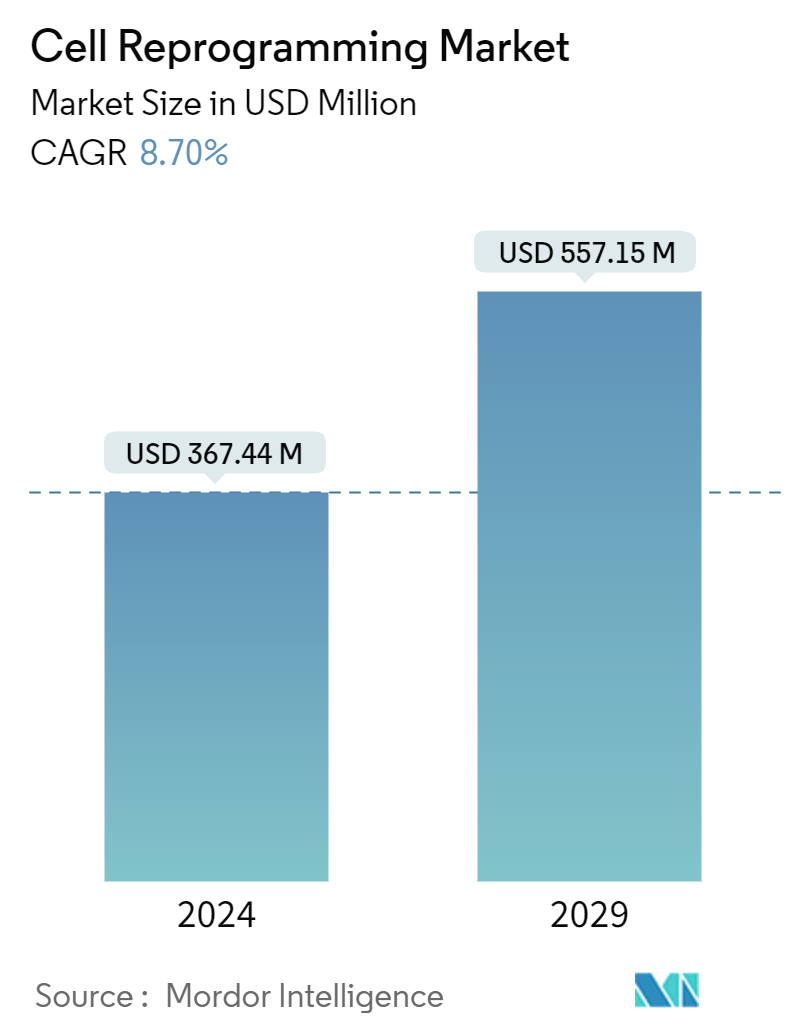
| Study Period | 2019 - 2029 |
| Market Size (2024) | USD 367.44 Million |
| Market Size (2029) | USD 557.15 Million |
| CAGR (2024 - 2029) | 8.70 % |
| Fastest Growing Market | Asia Pacific |
| Largest Market | North America |
Major Players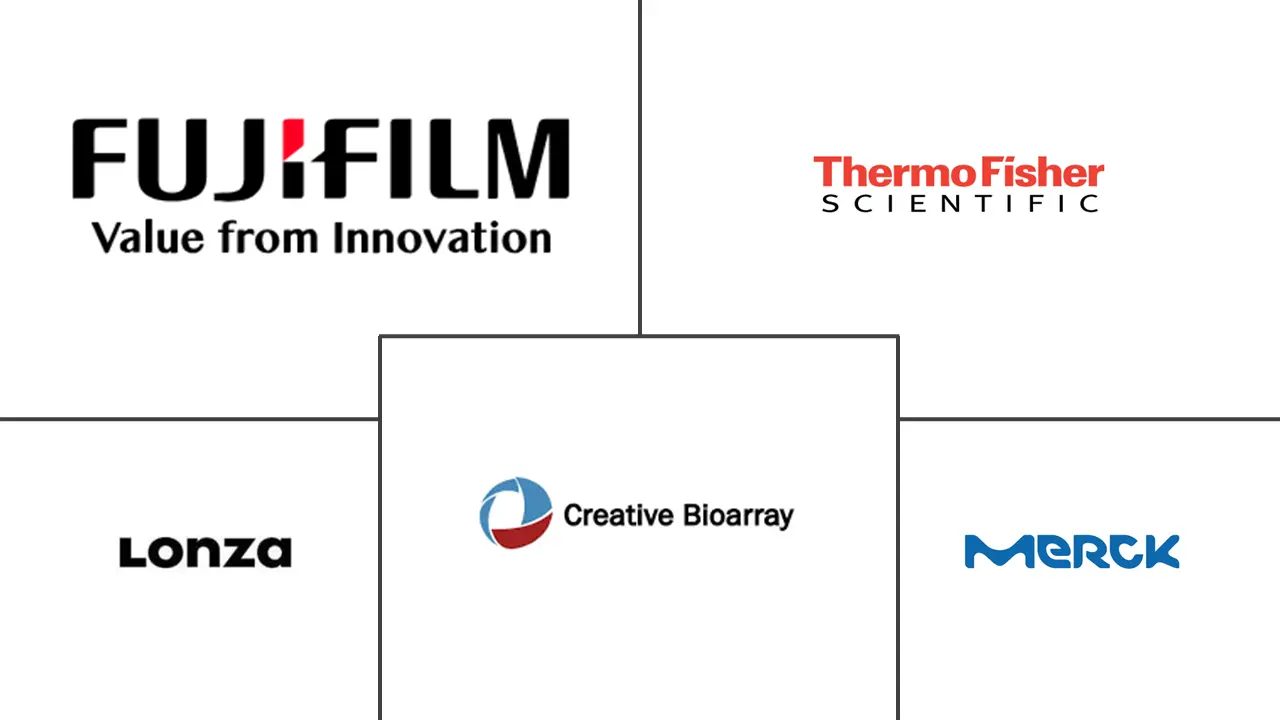
*Disclaimer: Major Players sorted in no particular order |
Cell Reprogramming Market Analysis
The Cell Reprogramming Market size is estimated at USD 367.44 million in 2024, and is expected to reach USD 557.15 million by 2029, growing at a CAGR of 8.70% during the forecast period (2024-2029).
The rapid rise in genetic disorders globally has strongly boosted the demand for research on cell reprogramming. Data from different regulatory bodies indicate the rising number of genetic disorders globally. According to April 2024 data from the European Commission’s EUROCAT, genetic anomalies were witnessed in 20.26 cases per 10,000 births in 2022, compared to 19.6 cases per 10,000 births in 2017 in Europe. Similarly, as per data from the Australian Institute of Health and Welfare (AIHW), 4,500 (or 1.7%) of Australian babies are born with congenital disabilities each year. The University of Michigan estimates that by 2040, amyotrophic lateral sclerosis (ALS) incidence will increase worldwide by 70%. With the rising population, the frequency of such defects is also rising, leading to the growing demand for research on cell reprogramming to treat human genetic and degenerative diseases such as Parkinson's disease or ALS. This is positively impacting market growth.
The increasing prevalence of chronic diseases, coupled with an aging population and increased technological advancement in the biotechnology field, is driving the growth of the cell reprogramming market. As populations age, there is a natural increase in the prevalence of chronic diseases, including cardiovascular and neurodegenerative disorders. Moreover, the aging process is intricately linked to cellular senescence, where cells experience irreversible growth arrest. For instance, in January 2024, researchers from New York’s Cold Spring Harbor Laboratory published a paper in the journal Nature Aging, which stated that the human body’s T cells can be reprogrammed to fight aging. The T cells can be used to fend off cells that increase as a person ages and cause inflammation, rendering the aging immune system less effective over time. Similarly, in January 2023, Rejuvenate Bio announced its preclinical research evaluating cellular reprogramming for age reversal, published in the preprint server bioRxiv. Such research on the applications of cell reprogramming is a primary driver of the market.
The cell reprogramming market has immense growth opportunities due to increasing strategic initiatives such as collaboration, launches, and other activities. For instance, in February 2024, Ginkgo Bioworks announced bit.bio as an inaugural partner of the Ginkgo Technology Network, an ecosystem of cutting-edge technology providers who will collaborate with Ginkgo to provide new, integrated R&D programs. Similarly, in May 2023, Mekonos announced its partnership with bit.bio for precision cell reprogramming technology to increase the development of human cells for research, next-generation cell therapies, and drug discovery. Such partnerships promote the application of cell reprogramming, driving market growth.
Technological advancements have substantially improved the efficiency and safety of inducing pluripotency in cells. Novel reprogramming factors and precise delivery methods contribute to increased efficacy, a critical factor for the scalability and practical implementation of cell reprogramming in diverse therapeutic contexts. These technologies enable precise and targeted genome modification, facilitating the development of disease-specific cellular models for research and drug discovery. For instance, in October 2023, Tenaya Therapeutics published preclinical data in circulation, highlighting the clinical potential of cell reprogramming for cardiac regeneration.
Market growth is also influenced by advancements in automation and robotics in cell manufacturing. Automated systems streamline the production of reprogrammed cells, ensuring consistency, scalability, and compliance with regulatory standards. For instance, in January 2023, Automata announced its partnership with bit.bio, to automate a vital aspect of the manufacturing process of iPSC (induced pluripotent stem cell)-derived human cell products.
Thus, the increasing prevalence of chronic diseases, coupled with an aging population and increasing technological advancement, is driving the growth of the cell reprogramming market.
Cell Reprogramming Market Trends
The mRNA Reprogramming Segment is Expected to Witness Significant Growth Over the Forecast Period
The mRNA reprogramming segment is expected to dominate the market due to its versatile application in manipulating cellular functions. Widely known for its application in vaccine development, it has also extended its application to significantly impact the field of regenerative medicine and cell reprogramming.
The technology allows the precise design of mRNA to carry specific genetic instructions into cells, thereby directing them to produce targeted proteins or undergo desired functional changes. This adaptability positions mRNA as a powerful tool for reprogramming cells in a controlled and tailored manner.
Speed and efficiency are other factors that influence the growth of the segment. Compared to traditional methods involving viral vectors, which are time-consuming and pose safety concerns, mRNA synthesis is rapid and easily modifiable. Safety consideration plays a significant role in therapeutic approaches, and mRNA technology boasts a favorable safety profile. The success of the COVID-19 vaccine significantly enhanced the confidence in technology, attracting substantial investments and interest from research institutes and biopharmaceutical companies.
In addition to its therapeutic application, mRNA technology offers scalability, a crucial factor for commercial success. Its ability to efficiently produce large quantities of standardized mRNA sequences makes it conducive for widespread clinical application. For instance, in May 2023, Turn Biotechnologies, a cell reprogramming company developing novel mRNA medicines for untreatable, age-related conditions, showcased data on transient reprogramming with the company’s mRNA platform Epigenetic Reprogramming of Aging (ERA) technology rejuvenates cells within the extracellular matrix (ECM). Such research data showcases the rising application of mRNA reprogramming for varied clinical applications.
Therefore, versatile applications in manipulating cellular functions, speed, and efficiency are some of the factors that are expected to drive the growth of the segment over the forecast period.
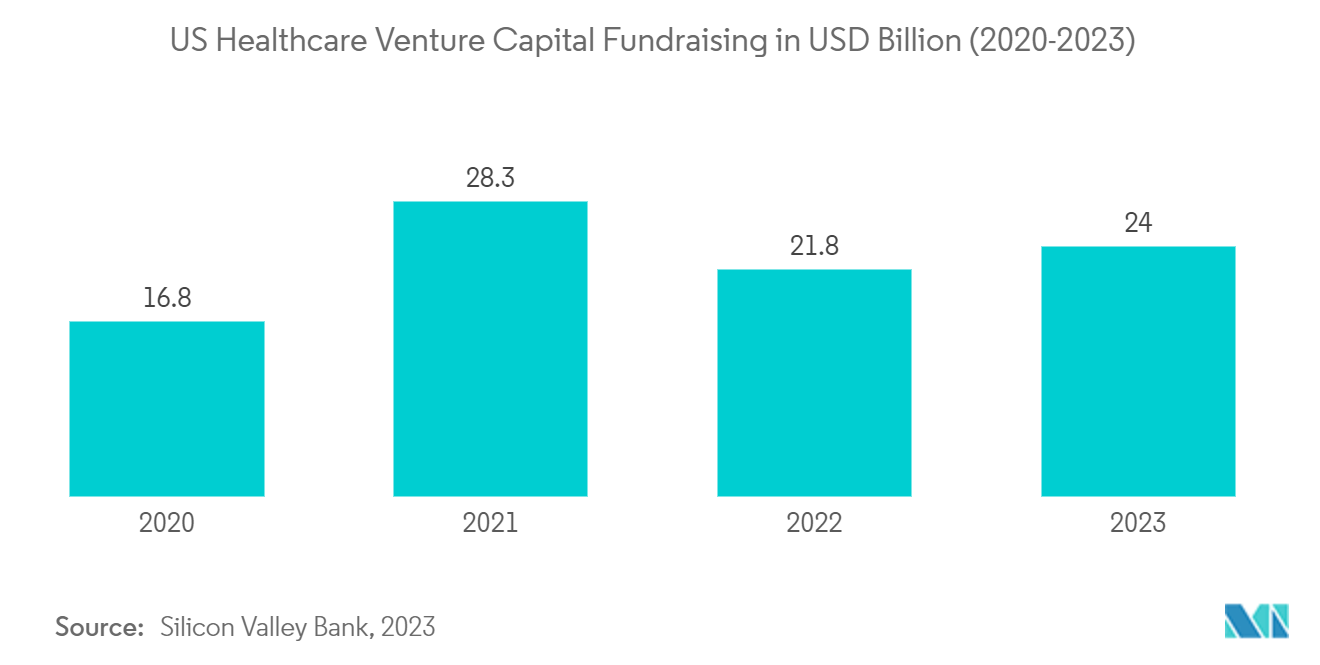
North America is Expected to Dominate the Cell Reprogramming Market Over the Forecast Period
North America is expected to dominate the cell reprogramming market over the forecast period as it is a focal point for substantial investment in biotechnology and healthcare. This financial backing facilitates extensive research and development initiatives, empowering the exploration of cutting-edge technologies, including mRNA-based cell reprogramming. The financial support accelerates the pace of discoveries and supports the clinical translation of promising cellular therapies, reinforcing the region's dominance in the market. For instance, in October 2023, the Canadian Minister of Health announced an investment of USD 15 million to create a Pan-Canadian Genome Library that is expected to allow easier sharing of genomic data across the country. Similarly, in April 2023, the Canadian Minister of Innovation, Science and Industry announced federal support of USD 18.1 million through Genome Canada for 13 late-stage R&D projects pertaining to major health, environment, and agriculture challenges through genomics. Such government support for genetic research drives the cell reprogramming market in the region.
Well-established research ecosystems and robust healthcare infrastructure positively influence market growth. The region boasts world-renowned research institutions, academic centers, and biotechnology companies, creating an environment conducive to innovation in cell reprogramming. This concentration of expertise and resources allows North America to be a hub for groundbreaking research and the translation of scientific advancement into commercially viable cell reprogramming therapy. Additionally, several new research facilities are being developed in the region, suggesting the growing demand for genetic research programs. For instance, in October 2023, New York's first cell and gene therapy hub was announced. It was expected to be built inside the Roswell Park Comprehensive Cancer Center in Buffalo, Erie County, for an investment of USD 98 million. Such developments further bolster the cell reprogramming market.
Therefore, substantial investment in biotechnology and healthcare, well-established research ecosystems, and robust healthcare infrastructure are significant factors influencing the growth of the market in North America.
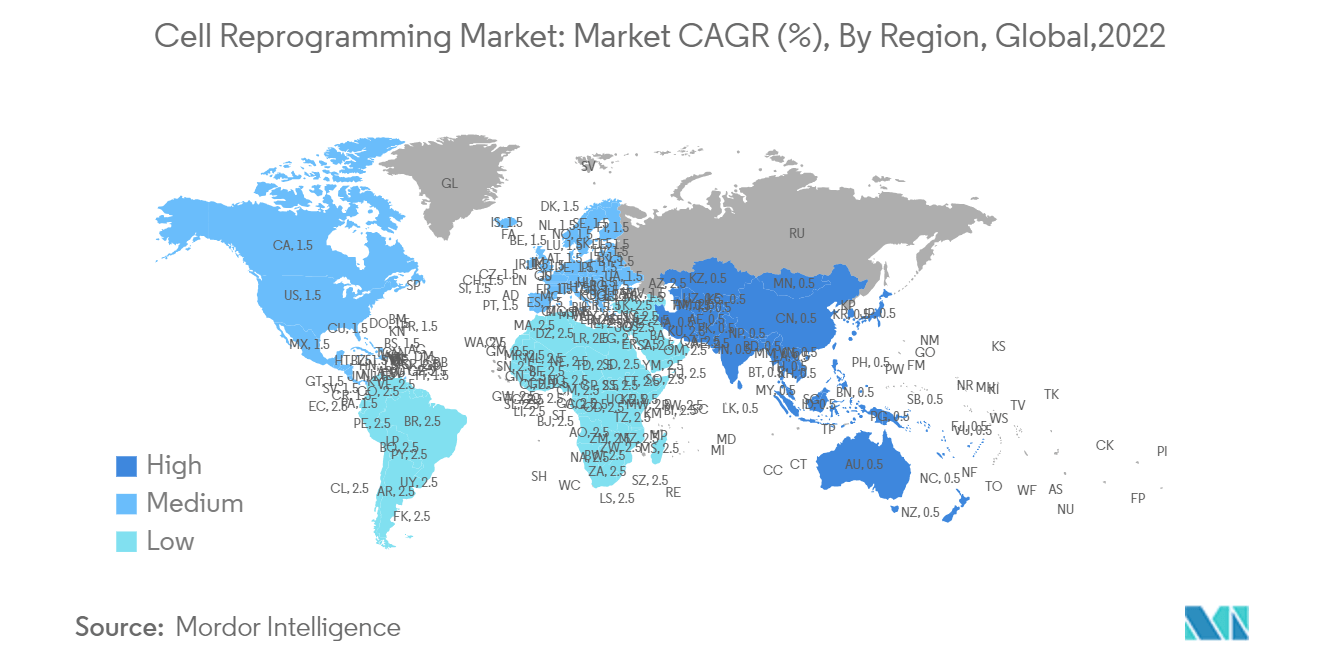
Cell Reprogramming Industry Overview
The cell reprogramming market is semi-consolidated due to a few companies accounting for a moderate share of the market. The competitive landscape includes an analysis of a few international as well as local companies that hold substantial market share and are well known, including Thermo Fisher Scientific Inc., Merck KGaA, FUJIFILM Corporation, Lonza, and Creative Bioarray, among others.
Cell Reprogramming Market Leaders
-
Thermo Fisher Scientific Inc.
-
Merck KGaA
-
Lonza
-
Creative Bioarray
-
FUJIFILM Corporation
*Disclaimer: Major Players sorted in no particular order
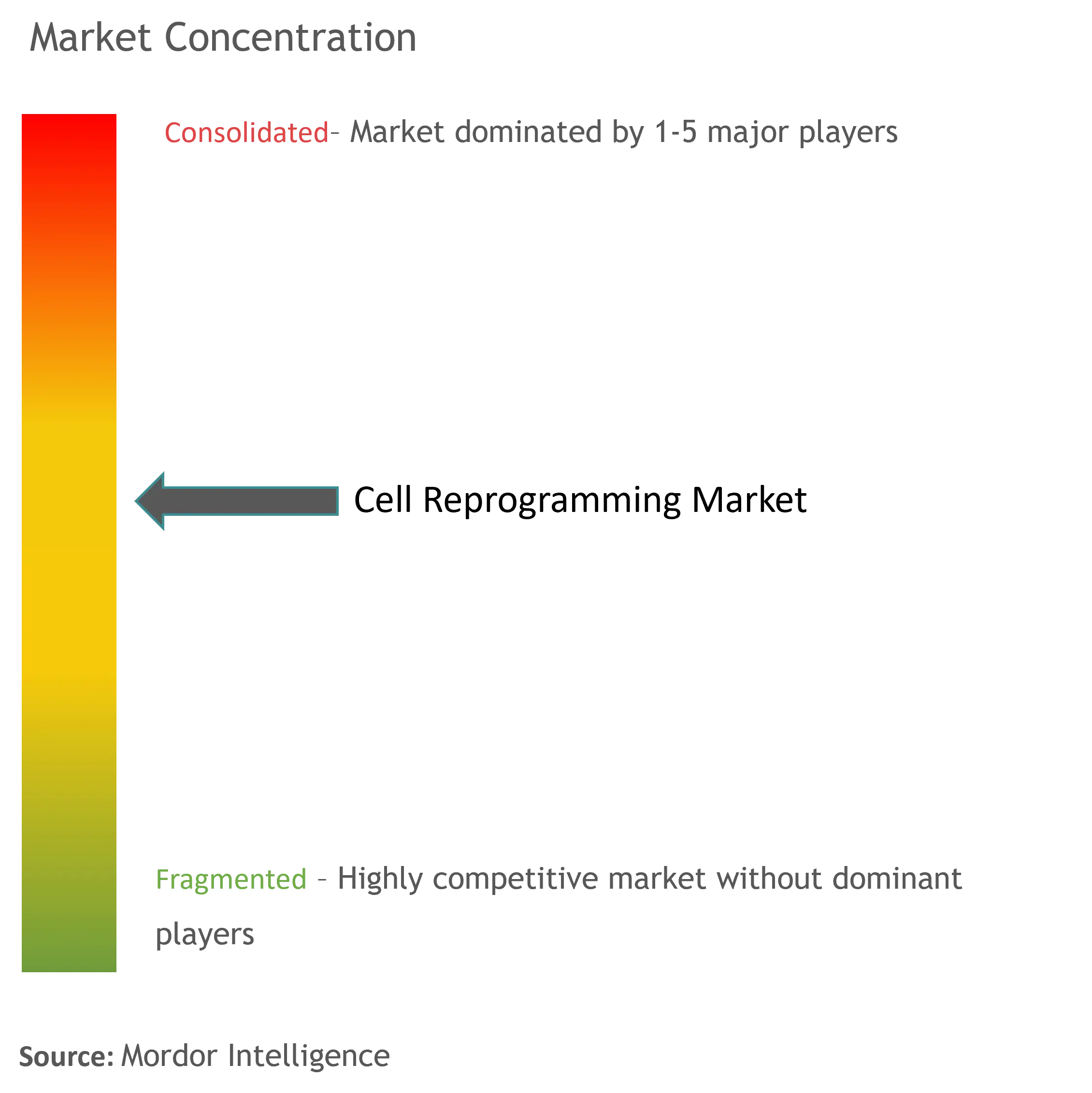
Cell Reprogramming Market News
- March 2024: Asgard Therapeutics, a Sweden-based gene therapy biotechnology company, announced receiving USD 32.6 million in Series A funding to advance its first-in-class in vivo cell reprogramming platform for immuno-oncology.
- February 2024: Rejuvenate Bio announced the publication of the study, titled "Gene Therapy-Mediated Partial Reprogramming Extends Lifespan and Reverses Age-Related Changes in Aged Mice," in the peer-reviewed journal Cellular Reprogramming. The study revealed promising advancements in combating age-related diseases and extending lifespan through cellular rejuvenation.
Cell Reprogramming Market Report - Table of Contents
1. INTRODUCTION
- 1.1 Study Assumptions and Market Definition
- 1.2 Scope of the Study
2. RESEARCH METHODOLOGY
3. EXECUTIVE SUMMARY
4. MARKET DYNAMICS
- 4.1 Market Overview
-
4.2 Market Drivers
- 4.2.1 Increasing Prevalence of Chronic Disease Coupled with Aging Population
- 4.2.2 Increased Technological Advancement in the Field of Biotechnology
-
4.3 Market Restraints
- 4.3.1 Adverse Effects Associated with Cell Reprogramming Technique
-
4.4 Porter's Five Force Analysis
- 4.4.1 Threat of New Entrants
- 4.4.2 Bargaining Power of Buyers/Consumers
- 4.4.3 Bargaining Power of Suppliers
- 4.4.4 Threat of Substitute Products
- 4.4.5 Intensity of Competitive Rivalry
5. MARKET SEGMENTATION (Market Size by Value - USD)
-
5.1 By Technology
- 5.1.1 Sendai Virus Reprogramming
- 5.1.2 Episomal Reprogramming
- 5.1.3 mRNA Reprogramming
- 5.1.4 Other Technology Type
-
5.2 By Application
- 5.2.1 Research
- 5.2.2 Therapeutics
-
5.3 By End User
- 5.3.1 Research & Academic Institutes
- 5.3.2 Biotechnology & Pharmaceutical Companies
-
5.4 Geography
- 5.4.1 North America
- 5.4.1.1 United States
- 5.4.1.2 Canada
- 5.4.1.3 Mexico
- 5.4.2 Europe
- 5.4.2.1 Germany
- 5.4.2.2 United Kingdom
- 5.4.2.3 France
- 5.4.2.4 Italy
- 5.4.2.5 Spain
- 5.4.2.6 Rest of Europe
- 5.4.3 Asia-Pacific
- 5.4.3.1 China
- 5.4.3.2 Japan
- 5.4.3.3 India
- 5.4.3.4 Australia
- 5.4.3.5 South Korea
- 5.4.3.6 Rest of Asia-Pacific
- 5.4.4 Rest of the World
6. COMPETITIVE LANDSCAPE
-
6.1 Company Profiles
- 6.1.1 Thermo Fisher Scientific Inc.
- 6.1.2 Merck KGaA
- 6.1.3 FUJIFILM Corporation
- 6.1.4 Lonza
- 6.1.5 Creative Bioarray
- 6.1.6 Allele Biotechnology
- 6.1.7 ALSTEM
- 6.1.8 Axol
- 6.1.9 REPROCELL Inc.
- 6.1.10 Mogrify Limited
- 6.1.11 Stemnovate
- *List Not Exhaustive
7. MARKET OPPORTUNITIES AND FUTURE TRENDS
** Subject To AvailablityCell Reprogramming Industry Segmentation
As per the scope of the report, cell reprogramming is a process in which the identity and characteristics of differentiated cells are altered, typically by inducing the expression of specific genes or manipulating cellular factors. Cell reprogramming aims to convert a specialized cell, often somatic or differentiated, into another cell type.
The cell reprogramming market is segmented into technology, application, end user, and geography. The market is segmented by technology into Sendai virus reprogramming, episomal reprogramming, mRNA reprogramming, and other technology types. The market is segmented by application into research and therapeutics. By end user, the market is segmented into research & academic institutes and biotechnology & pharmaceutical companies. By geography, the market is segmented into North America, Europe, Asia-Pacific, and Rest of the World. The report also offers the market sizes and forecasts for 13 countries across the region. For each segment, the market sizing and forecasts were made on the basis of value (USD).
| By Technology | Sendai Virus Reprogramming | |
| Episomal Reprogramming | ||
| mRNA Reprogramming | ||
| Other Technology Type | ||
| By Application | Research | |
| Therapeutics | ||
| By End User | Research & Academic Institutes | |
| Biotechnology & Pharmaceutical Companies | ||
| Geography | North America | United States |
| Canada | ||
| Mexico | ||
| Geography | Europe | Germany |
| United Kingdom | ||
| France | ||
| Italy | ||
| Spain | ||
| Rest of Europe | ||
| Geography | Asia-Pacific | China |
| Japan | ||
| India | ||
| Australia | ||
| South Korea | ||
| Rest of Asia-Pacific | ||
| Geography | Rest of the World |
Cell Reprogramming Market Research FAQs
How big is the Cell Reprogramming Market?
The Cell Reprogramming Market size is expected to reach USD 367.44 million in 2024 and grow at a CAGR of 8.70% to reach USD 557.15 million by 2029.
What is the current Cell Reprogramming Market size?
In 2024, the Cell Reprogramming Market size is expected to reach USD 367.44 million.
Who are the key players in Cell Reprogramming Market?
Thermo Fisher Scientific Inc., Merck KGaA, Lonza, Creative Bioarray and FUJIFILM Corporation are the major companies operating in the Cell Reprogramming Market.
Which is the fastest growing region in Cell Reprogramming Market?
Asia Pacific is estimated to grow at the highest CAGR over the forecast period (2024-2029).
Which region has the biggest share in Cell Reprogramming Market?
In 2024, the North America accounts for the largest market share in Cell Reprogramming Market.
What years does this Cell Reprogramming Market cover, and what was the market size in 2023?
In 2023, the Cell Reprogramming Market size was estimated at USD 335.47 million. The report covers the Cell Reprogramming Market historical market size for years: 2019, 2020, 2021, 2022 and 2023. The report also forecasts the Cell Reprogramming Market size for years: 2024, 2025, 2026, 2027, 2028 and 2029.
Cell Reprogramming Industry Report
Statistics for the 2024 Cell Reprogramming market share, size and revenue growth rate, created by Mordor Intelligence™ Industry Reports. Cell Reprogramming analysis includes a market forecast outlook for 2024 to 2029 and historical overview. Get a sample of this industry analysis as a free report PDF download.



